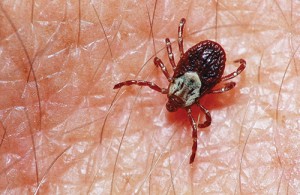
American Dog Tick. Photo courtesy of, and copyrighted by, Gene White, pmimages@earthlink.net
Fiction: All ticks carry Lyme disease.
Fact: The only ticks that transmit Lyme disease are the blacklegged species (Ixodes scapularis). This means you cannot get Lyme disease from other insect species like mosquitoes or flies.
Fiction: Ticks jump onto hosts passing trees.
Fact: Ticks do not have the ability to jump onto a host. Most often, ticks are found below knee level, waiting to be brushed off the end of a blade of grass or a leaf. Once they’re swept away by a host, they move toward warm, moist areas on the host’s body.
Fiction: Ticks burrow under the skin.
Fact: Ticks have a body part called a hypostome, which is about 1/8 in. long. It functions as a piercing straw to insert into the skin of a host.
Fiction: The best way to remove a tick is with a) a hot match; b) nail polish; c) rubbing alcohol; or d) petroleum jelly.
Fact: e) none of the above. Using any of those methods poses hazards, because the tick will react defensively and inject infected fluids back into the host. To remove a tick, grasp it with a pair of tweezers as close to the skin as possible and slowly pull it out. Be sure to pull straight; the hypostome has barbs, and trying to twist it out increases the chance of barbs breaking off.
Fiction: If the head breaks off under the skin, you’ll need a doctor to cut it out of you.
Fact: The body will treat a disembodied tick head like a splinter. The area might develop a localized infection as it works its way out of the skin.
Contact McGovern, a PMP and consultant, at jeffreymcgovern@mindspring.com.
Leave A Comment